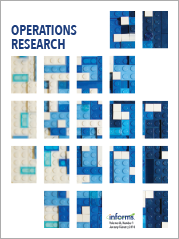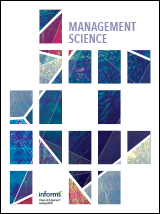Academic articles
Practitioner articles
Working papers
Books
Book chapters
Case studies
Other publications
Subject(s)
Management sciences, decision sciences and quantitative methods
Keyword(s)
research reliability, generalizability, archival data, reproducibility, context sensitivity
Volume
119
Journal Pages
2120377119
Subject(s)
Management sciences, decision sciences and quantitative methods
Keyword(s)
Brokering process, behavioral measure, relational events sequences, network algebra
Extant research in organizational networks has provided critical insights into understanding the benefits of occupying a brokerage position. More recently, researchers have moved beyond the brokerage position to consider the brokering processes (arbitration and collaboration) brokers engage in and their implications for performance. However, brokering processes are typically measured using scales that reflect individuals’ orientation toward engaging in a behavior, rather than the behavior itself. In this article, we propose a measure that captures the behavioral process of brokering. The measure indicates the extent to which actors engage in arbitration versus collaboration based on sequences of time stamped relational events, such as emails, message boards, and recordings of meetings. We demonstrate the validity of our measure as well as its predictive ability. By leveraging the temporal information inherent in sequences of relational events, our behavioral measure of brokering creates opportunities for researchers to explore the dynamics of brokerage and their impact on individuals, and also paves the way for a systematic examination of the temporal dynamics of networks.
With permission of SAGE Publishing
Volume
25
Journal Pages
459–489
Subject(s)
Human resources management/organizational behavior
Keyword(s)
Boundary spanning, supervisor undermining, territoriality, advice seeking
JEL Code(s)
M12
Volume
107
Journal Pages
1009–1019
Subject(s)
Management sciences, decision sciences and quantitative methods
Keyword(s)
Sequential decision making, time pressure, information search, Bayesian inference
Arrow et al. (1949) introduced the first sequential search problem, “where at each stage the options available are to stop and take a definite action or to continue sampling for more information." We study how time pressure in the form of task accumulation may affect this decision problem. To that end, we consider a search problem where the decision maker (DM) faces a stream of random decision tasks to be treated one at a time, and accumulate when not attended to. We formulate the problem of managing this form of pressure as a Partially Observable Markov Decision Process, and characterize the corresponding optimal policy. We find that the DM needs to alleviate this pressure very differently depending on how the search on the current task has unfolded thus far. As the search progresses, the DM is less and less willing to sustain high levels of workloads in the beginning and end of the search, but actually increases the maximum workload she is willing to handle in the middle of the process. The DM manages this workload by first making a priori decisions to release some accumulated tasks, and later by aborting the current search and deciding based on her updated belief. This novel search strategy critically depends on the DM's prior belief about the tasks, and stems, in part, from an effect related to the decision ambivalence. These findings are robust to various extensions of our basic set-up.
© 2019, INFORMS
Volume
70
Journal Pages
1293–1952
Subject(s)
Human resources management/organizational behavior
Keyword(s)
Employer attractiveness, organizational commitment, current employees, existing employees, employer brand
JEL Code(s)
M12
With the growing interest in employer attractiveness, research is unsystematic on how this phenomenon can be conceptualized and studied. Studies tend to make little conceptual differentiation regarding for whom employers should be attractive, and therefore, address the perspectives of potential as well as current employees, who work in organizations for long periods of time. In this study our arguments relate to the phenomenon’s conceptual clarity as well as its differentiation from other related concepts. By focusing on employer attractiveness for current employees, we have systematically reviewed 48 studies published in business and management journals, and categorized findings into the Inputs-Mediators-Outputs model. This approach allowed us to depict significant limitations in the existing knowledge about employer attractiveness from the current employees’ perspective, and offer avenues for future research. Next, to delineate the future research agenda, we have concluded this study with a discussion on what our findings mean for managers and organizations.
© 2022 Dassler, Khapova, Lysova and Korotov
Volume
13
Keyword(s)
hedge funds, cash flows, hot hand fallacy, performance streaks, relative weights, smart money
Cash flows to hedge funds are highly sensitive to performance streaks, a streak being defined as subsequent quarters during which a fund performs above or below a benchmark, even after controlling for a wide range of common performance measures. At the same time, streaks have limited predictive power regarding future fund performance. This suggests investors weigh information suboptimally, and their decisions are driven too strongly by a belief in continuation of good performance, consistent with the “hot hand fallacy.” The hedge funds that investors choose to invest in do not perform significantly better than those they divest from. These findings are consistent with overreaction to certain types of information and do not support the notion that sophisticated investors have superior information or superior information processing abilities.
© 2021, INFORMS
Volume
68
Journal Pages
4151–4172
ISSN (Online)
1526-5501
ISSN (Print)
0025–1909
Subject(s)
Technology, R&D management
Keyword(s)
patents, drugs, data exclusivity, clinical trials
JEL Code(s)
K41, L24, L65, O31, O32, O34
Volume
104
Journal Pages
574–586
Subject(s)
Human resources management/organizational behavior
Keyword(s)
methods, measures, research transparency, open science,reproducibility, meta-science, negotiation,conflict, cooperation, competition
Conflict management scholars study mixed-motive negotiation situations with cooperative and competitive incentives predominantly through multi-issue negotiation tasks in experimental studies. Intriguingly, experimenters currently lack an objective, generalizable, and continuous measure that precisely quantifies the incentives underlying these negotiation tasks. We present the conflict strength coefficient, which enables scholars to systematically quantify the incentive structures in these multi-issue negotiation tasks. By making the incentive structures accessible and numerically comparable, the conflict strength coefficient provides new insights into the central element of the experimental study of negotiation and conflict management, unmasks differences across existing tasks, facilitates research transparency, knowledge sharing, and open science practices. We demonstrate the coefficient’s benefits by providing a hands-on example from past research, by reviewing and quantitatively assessing the current literature, and by mapping conflict strength coefficients for the negotiation and conflict management research landscape and its subareas. Our analysis suggests that the conflict strength coefficient can enrich the understanding of cooperative and competitive incentives in the established tasks and directly guide and support an individual scholar’s process of knowledge creation. The conflict strength coefficient provides a methodological contribution to the experimental study of conflict management and negotiation with immediate benefits for the production of scientific knowledge, the experimental study of real-world phenomena, and theory development.
Volume
8
Subject(s)
Strategy and general management; Technology, R&D management
Keyword(s)
autonomy, remote work, flat organizations
Volume
11
Journal Pages
27–29
ISSN (Online)
2245-408X
Subject(s)
Unspecified
Keyword(s)
attorney perceptions, sexual violence, coercive tactics, measurement, cross-cultural research
In order to study sexual violence internationally, it is helpful to understand similarities and differences in how sexual violence is conceptualised across countries. The current study examined prosecuting attorneys’ judgments about which sexual tactics legally qualify as sexual violence in two countries. Attorneys from the U.S. (n = 28) and Colombia (n = 24) evaluated whether 36 tactics would qualify as a sexual offense in their jurisdiction. Although Colombian and U.S. attorneys agreed on the legality of many tactics, Colombian attorneys judged more behaviours as criminal, on average, than U.S. attorneys. Within-country variations suggested that differences were due not only to different legal statutes, but also to different interpretations of laws. Open-ended responses illustrated sources of ambiguity, including lack of clarity about how much coercion is required and which behaviours indicate nonconsent. This suggests that vagueness within legal definitions may allow attorney judgements to be influenced by stereotypes and prejudices.
Practical Impact Statement: This study illustrates the vagueness of legal definitions of sexual violence in two countries—the United States and Colombia. This vagueness provides prosecuting attorneys with substantial power to interpret the law, and in this study, some attorney judgements of legality seemed to be influenced by stereotypes. Greater training for law students and attorneys about the realities of sexual violence may be helpful in undermining belief in rape myths that may inhibit attorneys from prosecuting certain sexual violence cases.
Practical Impact Statement: This study illustrates the vagueness of legal definitions of sexual violence in two countries—the United States and Colombia. This vagueness provides prosecuting attorneys with substantial power to interpret the law, and in this study, some attorney judgements of legality seemed to be influenced by stereotypes. Greater training for law students and attorneys about the realities of sexual violence may be helpful in undermining belief in rape myths that may inhibit attorneys from prosecuting certain sexual violence cases.
Volume
28
Journal Pages
261–279
ISSN (Online)
1742-6545
ISSN (Print)
1355-2600



